You’ll be hard-pressed to find a “shark-toothed” theropod model as decked-out and detailed as this one, although a couple of design flaws might have one hesitating at the retail price.
Carcharodontosaurs have ranked among my favorite dinosaurs since early childhood – the notion of meat-eaters even bigger than the mighty Tyrannosaurus was simply too irresistible to my 5-year-old self, and that initial shock and awe has remained embedded in my psyche to this day. Conversely, there are enough giant predatory dinosaurs known now, which have been touted as the latest “biggest” meat-eater, that if I’m not careful I almost take for granted how huge dinosaurs really did get by the standards we’re used to in land animals today. I can only attempt to imagine how exhilarating (and terrifying) it would have been during the Cretaceous period to encounter any one of these super-predators alive in the flesh.

Most of the biggest theropods currently known to science have been described in the past 30 years, and a good majority of these are classified within the family of carcharodontosauridae, or “jagged-toothed reptiles” (in reference to the similar-looking teeth of Carcharodon carcharias, the great white shark). However, the namesake genus of the group, Carcharodontosaurus saharicus, was described far earlier in 1934 by German paleontologist Ernst Stromer, alongside Spinosaurus and various other genera new for the time. Due to the fragmentary nature of the fossils – and their tragic destruction by allied bombers after being abandoned in the Berlin Museum during WWII – Carcharodontosaurus would languish in obscurity until 1995, when a more complete skull was discovered and described by the team of Paul Sereno. This discovery followed the announcement of a brand-new relative from Argentina, Giganotosaurus, only the year before; it was an exciting time for dinosaur fans who were used to T. rex as the unrivaled “king of the dinosaurs”.
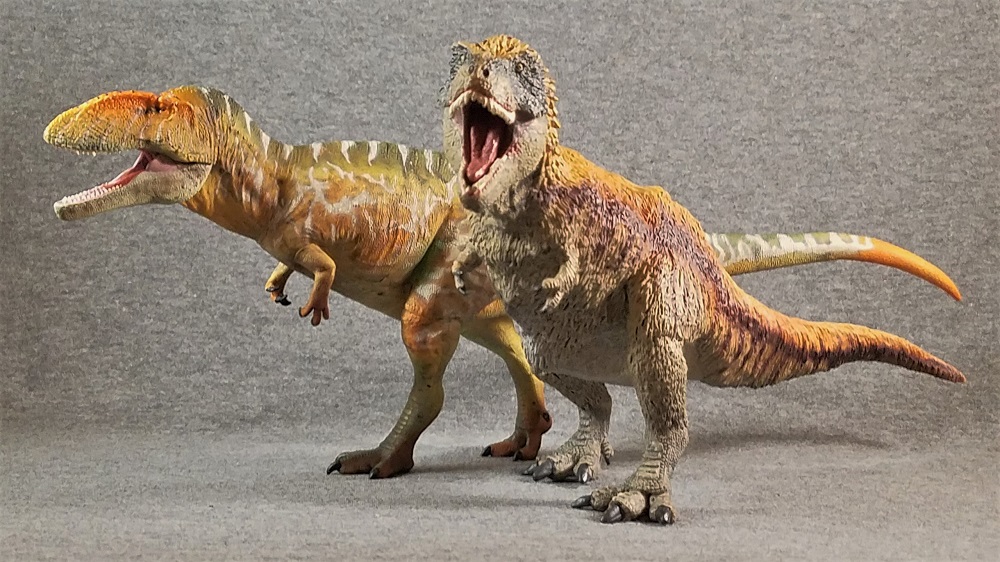
The first Carcharodontosaurus toy was released by Safari ltd. in 1996/1997, when scientifically accurate, high-quality dinosaur toys were still in their early years of development. Twenty-five years later, the market and production methods for this collecting niche have evolved dramatically; and the replicas have advanced to reflect this appropriately. There have been several takes on Carcharodontosaurus since 1997, and in 2021 a total of three different companies tackled the “shark-toothed” dinosaur anew. The most dramatic of these new models is unquestionably that of GR Toys, a model store based in Beijing, China, and with a prominent presence on the online shopping platform Taobao. GR Toys entered the dinosaur toy market in 2020 with an impressive Spinosaurus model produced by Mu See studios, and for their second release the following GR Toys collaborated with the studio Haolonggood to present Africa’s second famous predatory giant of the Cretaceous. GR Toys would collaborate with Haolonggood twice more in 2021 and 2022 to release models of Dicraeosaurus and Quetzalcoatlus, before strife between MuSee and Haolonggood evidently prompted the former trio of partners work separately.


GR Toys has established a double-variant release standard for their models; Carcharodontosaurus was presented with “blue” and “flame” versions for the market. While the blue, or “rainbow” version as some nicknamed it, seems to have gotten the most attention online – perhaps due simply to having been the first version released by a month’s difference – the flame (or red/orange) version is nothing to scoff at. The flame model is decked out in a rich fiery-orange and yellow wash, apt for its name, along most of the body, with the most vivid markings splashed on the face and tip of the tail. Dark green accentuates the backbone and feet, with an off-white blending across the underbelly and jaw. Heavier white markings adorn the body in a variety of patterns – long, slender stripes across the face, thicker stripes perpendicular across the neck and back, and a dynamic surge of irregular interconnected markings running the entire course of the side of the body like a stylized electrical charge. A few scattered black markings further accentuate the contrast of colors, most notably on the face where sharp tiger stripes cross the brow and nasal bridge.
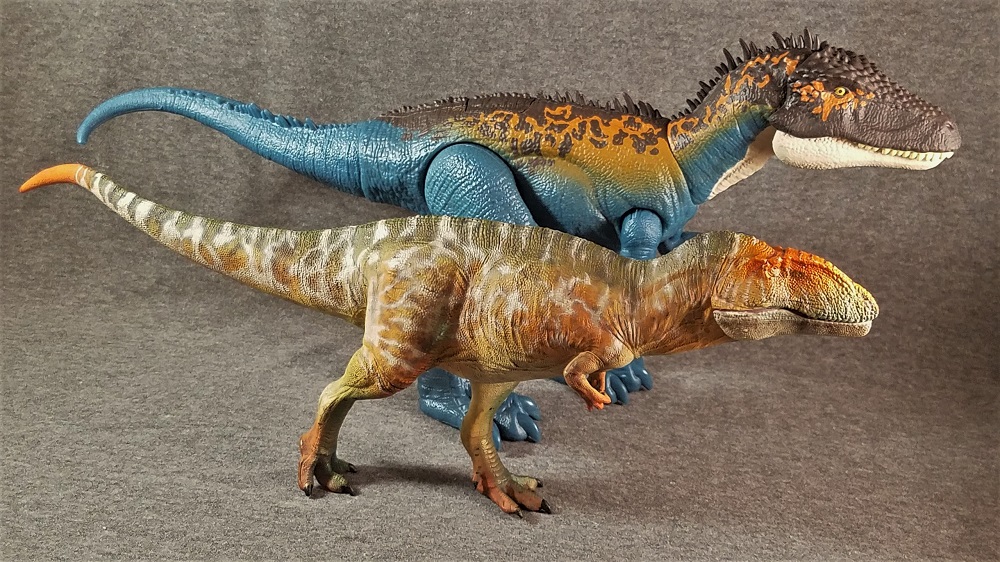
When the first photos were published of the models, collectors were understandably skeptical of whether the mass-produced models could match the intricacy of the prototypes. Clearly, however, a lot of care went into the paint process for this figure to maintain the quality advertised. The minute eyes blend with the orange face, but are given a touch of gloss to distinguish from the surrounding scales. The teeth are painted neatly white, with a plum-purple mouth and reddish tongue. A few additional red highlights mark texture within the mouth. The claws on the hands and feet are fully painted glossy black with minimal signs of slop. Overall, this is an excellent and eye-catching color scheme which is reminiscent of the complex patterns seen in birds and reptiles today. Having played around briefly outside with the model, I could also envision this arrangement of colors actually being quite beneficial for camouflage; in an environment of mottled light and shadow, even a colossus like Carcharodontosaurus would eerily disappear within the marshy woodlands to ambush unwitting herbivores.
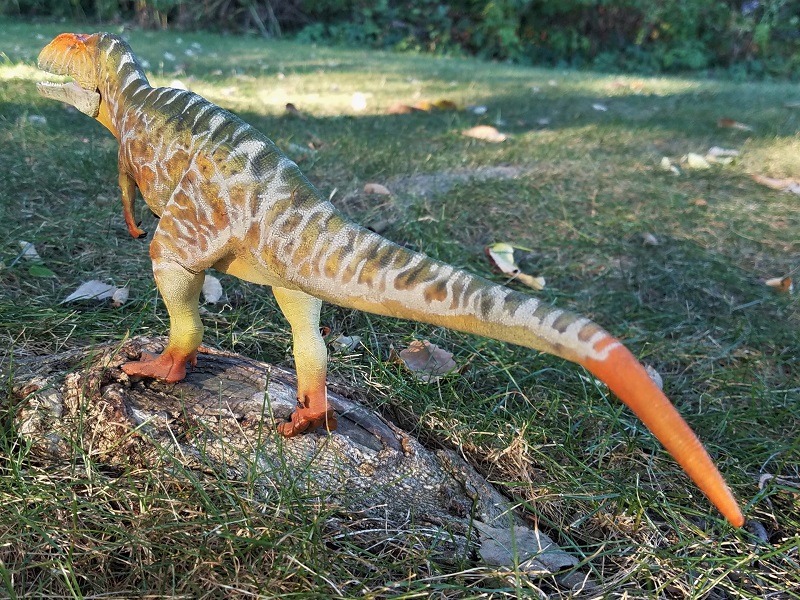
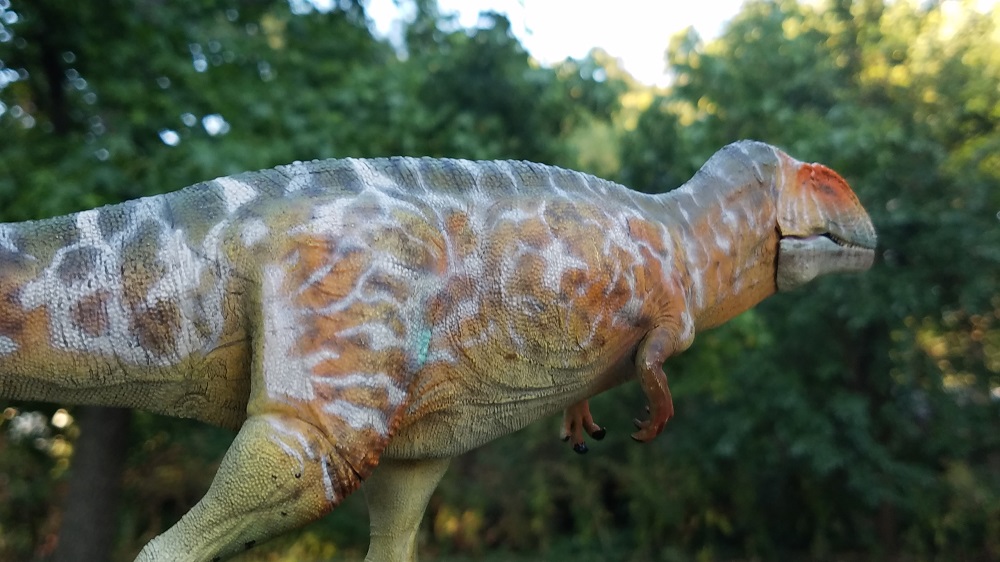
There are a few imperfections to the application which should be noted, even for as fine a model as this one. A few minor scuffs or dots of discoloration are present on the body upon close inspection, possibly from production or from the shipping & handling process. In some regions what appears to be the base black color of the model can show through the lighter paint areas, most notably on the undersides of the tail and belly. This might not be entirely a flaw, however, as I am reminded of how texture and colors on modern reptile skin will sometimes distort to reveal the tissue(?) between the scales. More obvious are somewhat random patches of bright aqua green on the front of each thigh and shin, which look like they were added as an afterthought. My biggest qualm with the coloration, however, would be with the lower jaw, which blends the off-white of the underbelly with a faint greenish tint and irregular brown speckles, and contrasts jarringly with the mostly orange neck and head. The resulting look uncomfortably resembles a five-O-clock shadow to me and I can’t unsee it now, even though it’s obviously nonsense for a hairless, featherless dinosaur. It’s the one personal gripe I would make regarding this otherwise impressive decoration.

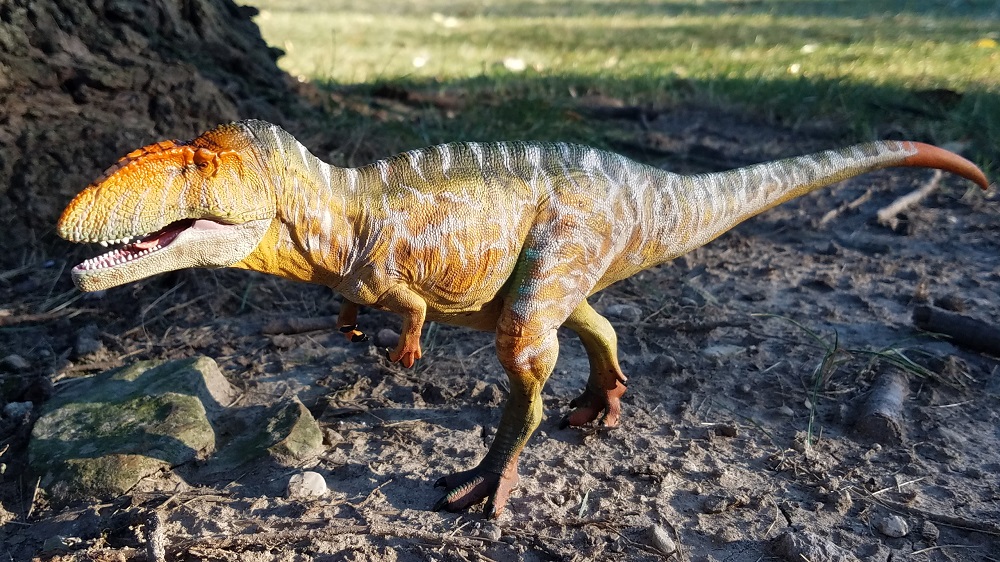
Elaborate coloration may be the most prominent feature of this model, but GR Toys and Haolonggood were diligent beyond the surface level. First of all, this Carcharodontosaurus is an imposing figure, measuring 36.5 cm (14.36 in) long from nose to tail, and 11 cm (4.25 in) tall at the hip. For a large individual measuring 12.8 meters in life, this model fits almost perfectly into 1:35 scale, and illustrates how enormous this theropod really might have been when compared with other 1:35 dino models, such as from Safari or PNSO. Every centimeter of this great model is dotted with fine, adjacent circular scales, with varying patterns and sizes across the body. Rounded scutes are just visible along the neck, transitioning to flat, rectangular scales down the top of the spine. Thicker, broader scales on the face and thighs transition to extremely fine scaling down the throat and lower legs, with modest wrinkling and stretching to reflect regions of skin with the most stress. The belly is patterned with mostly even rows of scales, which run all the way to the end of the tail. Interestingly, we actually do have scale impressions from a small relative, Concavenator, indicating larger scute-like scales along the tail; so Haolonggood might have missed an opportunity to depict a similar feature on Carcharodontosaurus as reasonable speculation.
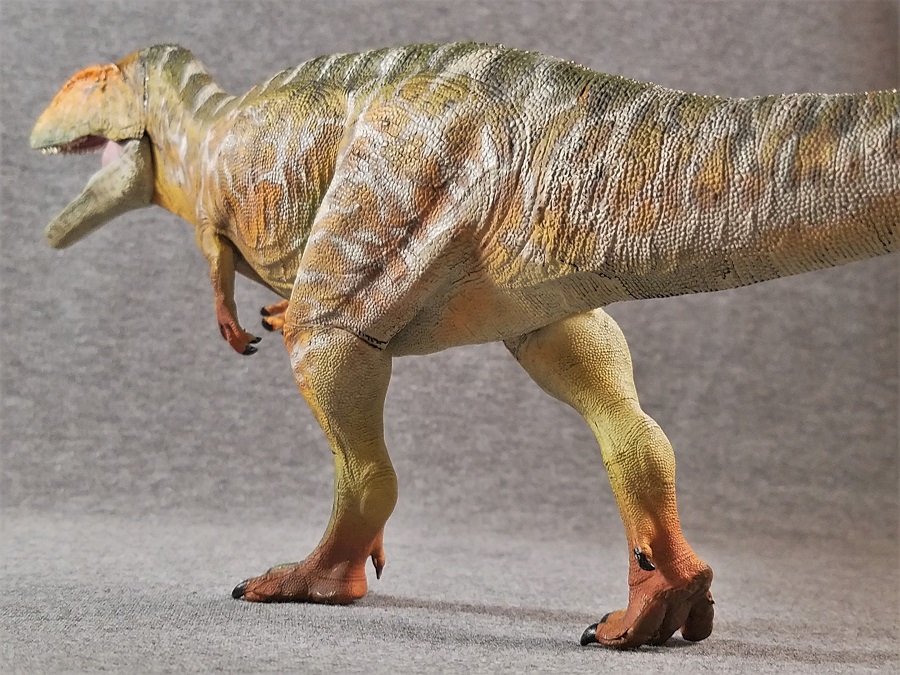
Although the true nature of the animal’s appearance is still unknown, this model generally does its best to capture reasonable anatomy based on inference from other carcharodontosaurs (apart from the aforementioned speculative tail scutes). The model features slightly raised neural spines, similar to the vertebrae seen in relatives like Giganotosaurus and Acrocanthosaurus, although less dramatically large. The forearms are proportionately small, but not atrophied; however there’s no evident size difference between the thumb claw and the other tow digit claws. The body is narrow, but deep; musculature is thorough but not exaggerated, depicting a healthy animal with a balanced physique. I’ve seen some skepticism that the caudofemoral muscles – which attach to the legs and stretch along the tail – could still afford to be thicker; but neither the pubic bones or any other bones appear exposed unnaturally on the body.
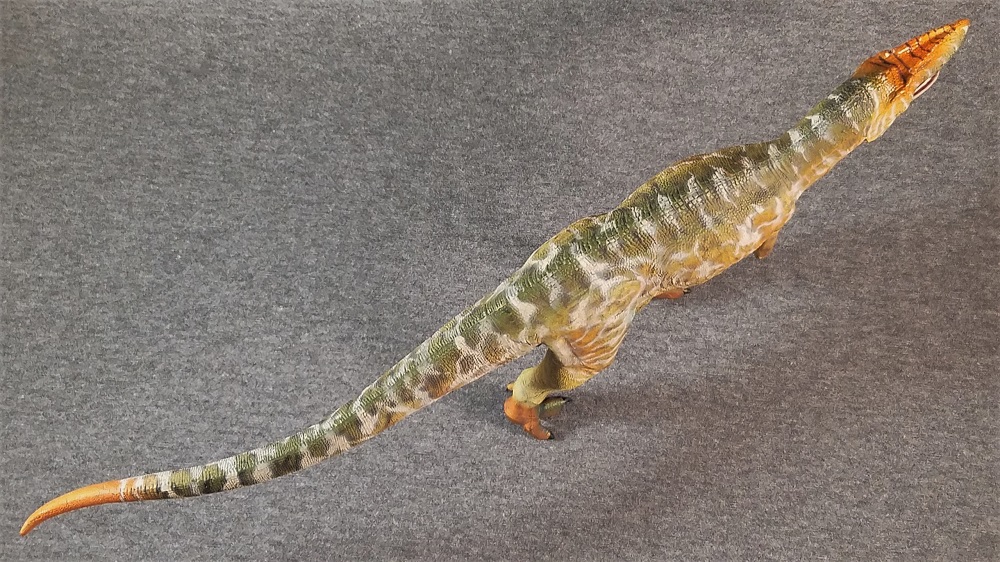
Most of what is known for Carcharodontosaurus comes from the skull, which is typically reconstructed with a long, elliptical shape rather than the boxy or arched shapes seen in tyrannosaurs and allosaurs (although more recent reconstructions suggest a rounder template for carcharodontosaur skulls more similar to the allosaurids). Haolonggood’s sculpt appears closest to the revised design seen in Ibrahim’s and Sereno’s 2020 monograph (which is largely similar to the 1995 Sereno reconstruction, with slightly more conservative dimensions), displaying the signature sloped nasal ridges to a softly rounded point of the snout. Additional soft tissue applied to the tip of the snout makes the skull appear slightly longer than it would from the skull alone. One question I have, however, is regarding the back of the skull, where the jugal and quadratojugal bones are reconstructed extending deeper and longer than I’m used to seeing in Carcharodontosaurus. The resulting skull appears more reminiscent of skull reconstructions typically seen for Giganotosaurus; admittedly more is known from this region of the skull in Giganotosaurus than in Carcharodontosaurus, so this might be a reasonable choice of creative license (although reconstructions of Giganotosaurus’s skull have been changing too).
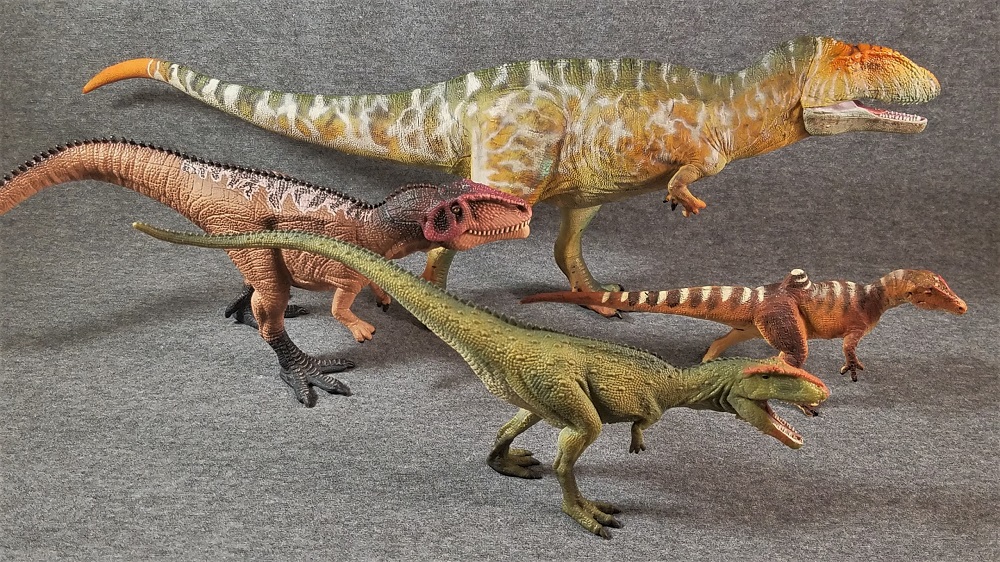
Like many dinosaur models in recent years, Carcharodontosaurus comes with an articulation joint in the jaw. Articulation can be hit or miss in application, but in this model’s case… It’s almost a hit. The range of jaw motion is good, and the choice of lipped appearance for the animal means the mouth is designed to seal nicely, allowing for a much more placid shelf display. The problem is, The jaw’s hinge seems to be very slightly offset, preventing the model’s mouth from sealing completely and resulting in what looks like a permanent snarl. It’s not a truly bad look, but it’s a bit of a letdown from what was advertised. It’s been almost 20 years since Papo popularized articulated dinosaur jaws, but companies are still struggling to refine the process.
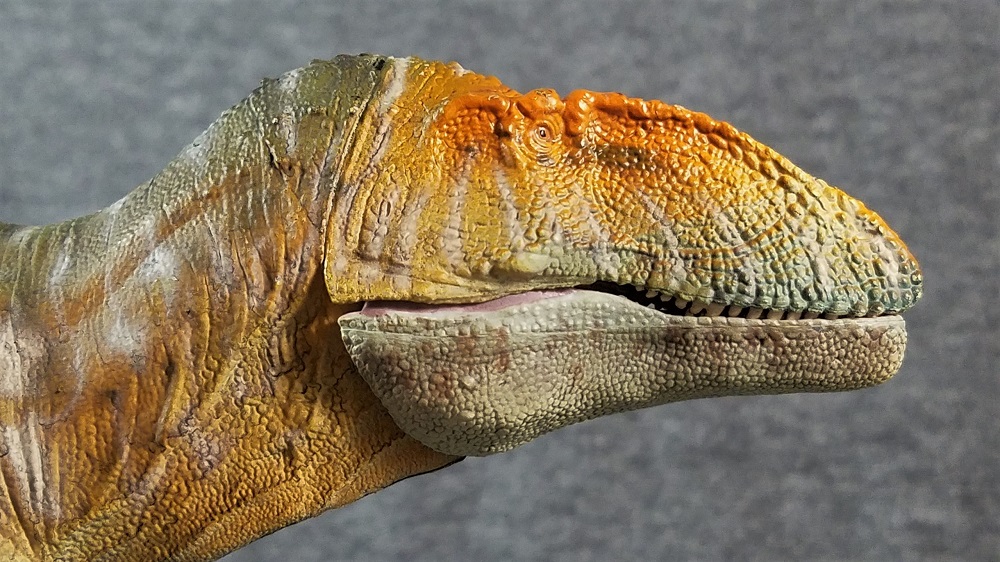
Another persisting issue present in Carcharodontosaurus is stability, ever the challenge for two-legged figures. This Carcharodontosaurus is posed mid-stride with head and tail straight out, supported only by its own two feet. No base or extra stand is included with the model, so the intent is for the big theropod to balance without trouble – which it does, almost. My copy of the model arrived secure in layers of Styrofoam packing, but something in production or handling still went wrong, because the figure’s feet aren’t level with each other. In fact, there’s almost a centimeter of difference in the height between the feet, which causes the model to teeter between its toes. Thankfully, my figure still maintains balance as long as it’s on a very stable flat surface; but there’s no telling if this balance will waver over longer periods of time. The plastic used is quite sturdy, at least – enough to resist reshaping from the traditional hot water treatment – so hopefully the figure will also be resistant to future warping.
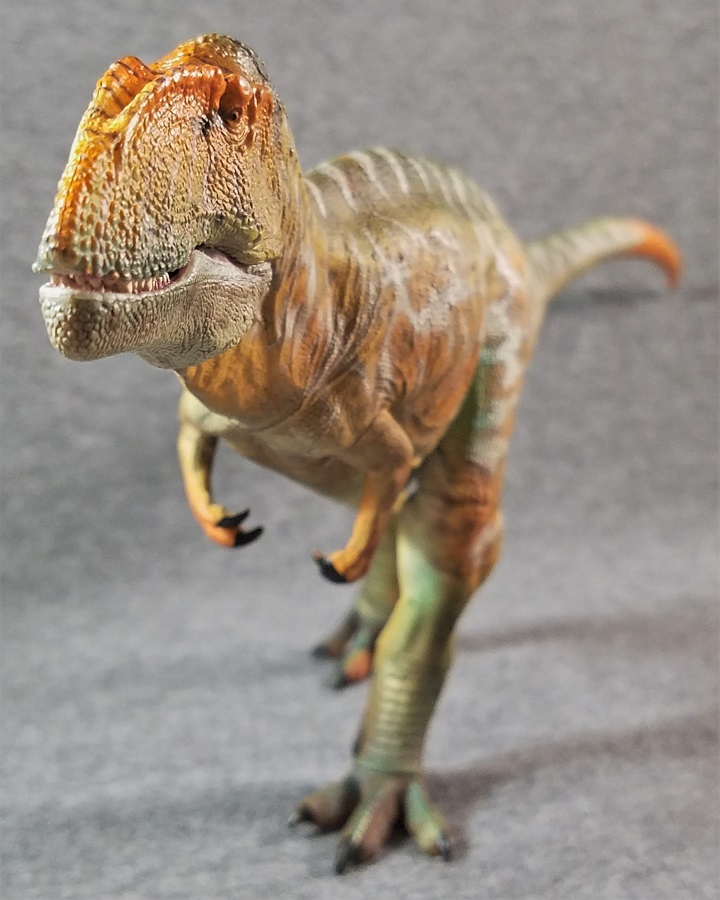
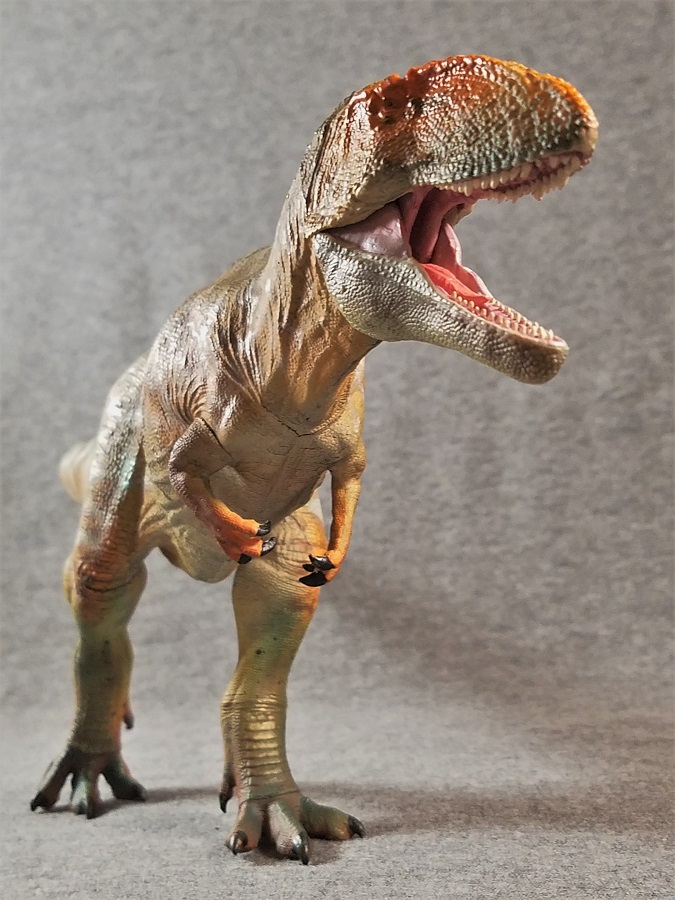

Although it’s regrettable GR Toys and Haolonggood haven’t yet overcome some basic feature issues – especially when much cheaper toys from other companies have accomplished it before – this Carcharodontosaurus is still a remarkable collector’s piece that looks and feels like a real animal being captured in miniature. Combine this model with PNSO’s “Gamba” figure from the same year, and I think it will be a real challenge for companies to produce their own rendition of the shark-toothed lizard that can stand as a worthy contender (unless new fossil material is discovered that warrants a revision to the animal’s appearance). Due to the smaller size and distribution of the parent companies, as well as the higher-end nature of the model, this item tends toward the expensive side of dinosaur “toys”, ranging from $40-50 and up. I advise avoiding eBay for this one, and checking AliExpress for the best prices (or possible discounts). You can also check Dan’s Dinosaurs, Lana Time Shop, or Dinosaur Time UK for more options. If you can find a price you like, the GR Toys/Haolonggood Carcharodontosaurus comes very recommended.
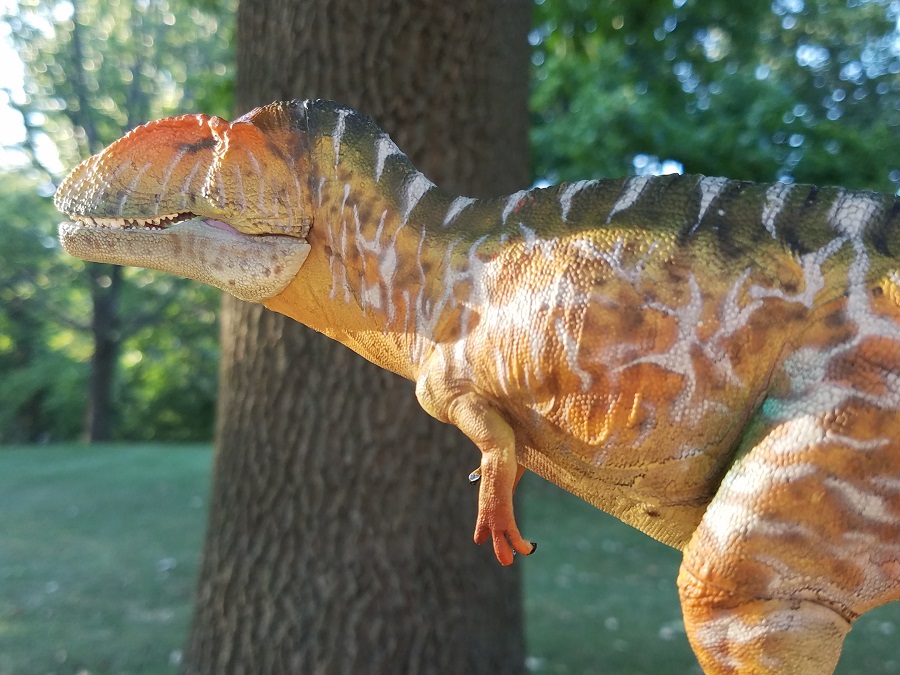
Disclaimer: links to Ebay and Amazon on the DinoToyBlog are affiliate links, so we make a small commission if you use them. Thanks for supporting us!




Gorgeous figure, maybe not as beautiful paint-up wise as the blue version, but a bit more realistically colored.
Picked one up for $32 Black Friday on AliExpress. How can you go wrong? At the time it came out, it was a flash of brilliance that foreshadowed the future of Haolonggood and its amazing, evolving dinosaur line that has now vaulted ahead of PNSO in my book. One of the early PVC theropod figures that “dared to lip”!
Good Lord I am running out of room to display them all! *LOL*
It’s a lovely figure, based on photos of both I actually prefer this one to the PNSO figure. Shame about the warped feet and lack of a stand though, hopefully in the future they’ll take a leaf out of PNSO’s book and include one, although there are obviously third party options and the good old “lean it against another figure” method. I might have to pick one up. Great review.
Great review and great model, but I personally like the PNSO model better. It looks very detailed but unfortunately it has many seams and from what I have read imperfections such as a figure prone to abrasions and that it has little stability, it would be interesting if GR Toys included, as PNSO does, a base or support rod for theropods, to avoid future imbalances . It’s a wonderfully extensive review and high-quality photographic credit. Sincerely from GR Toys, the star figures for me are the dicreaosaurus and the spinosaurus.
The PNSO is certainly impressive as well, from all the photos I’ve seen. I can only imagine how ecstatic I would have been 20 years ago as a kid to have the option of either of these models!
(not that I could have afforded either of them as a kid, but I digress…)